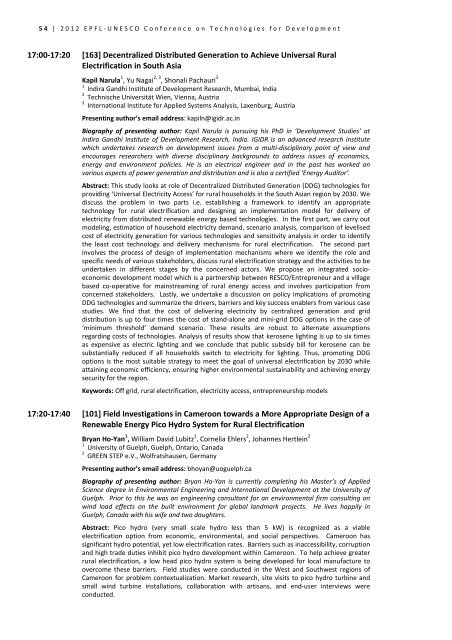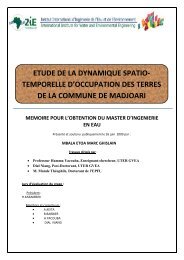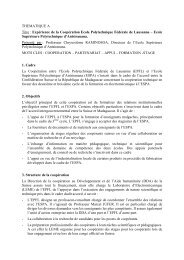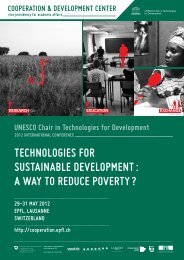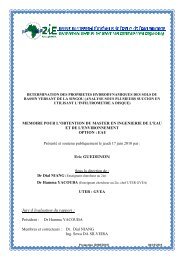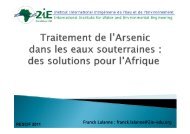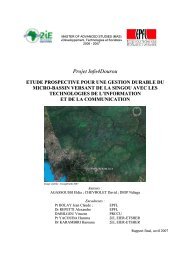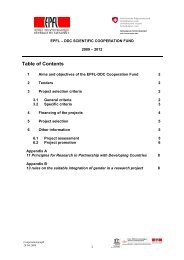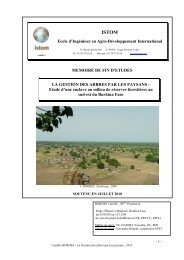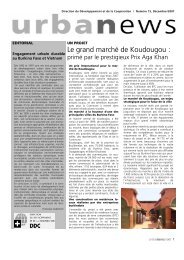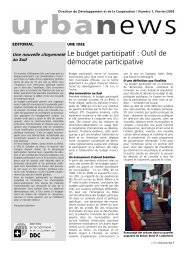TEChNOLOgIES FOR SuSTAINABLE DEVELOPMENT : A WAy TO ...
TEChNOLOgIES FOR SuSTAINABLE DEVELOPMENT : A WAy TO ...
TEChNOLOgIES FOR SuSTAINABLE DEVELOPMENT : A WAy TO ...
You also want an ePaper? Increase the reach of your titles
YUMPU automatically turns print PDFs into web optimized ePapers that Google loves.
54 | 2012 EPFL- UNESCO Conference on Technologies for Development17:00-17:20 [163] Decentralized Distributed Generation to Achieve Universal RuralElectrification in South AsiaKapil Narula 1 , Yu Nagai 2, 3 , Shonali Pachauri 31Indira Gandhi Institute of Development Research, Mumbai, India2Technische Universität Wien, Vienna, Austria3International Institute for Applied Systems Analysis, Laxenburg, AustriaPresenting author’s email address: kapiln@igidr.ac.inBiography of presenting author: Kapil Narula is pursuing his PhD in ‘Development Studies’ atIndira Gandhi Institute of Development Research, India. IGIDR is an advanced research institutewhich undertakes research on development issues from a multi-disciplinary point of view andencourages researchers with diverse disciplinary backgrounds to address issues of economics,energy and environment policies. He is an electrical engineer and in the past has worked onvarious aspects of power generation and distribution and is also a certified ‘Energy Auditor’.Abstract: This study looks at role of Decentralized Distributed Generation (DDG) technologies forproviding ‘Universal Electricity Access’ for rural households in the South Asian region by 2030. Wediscuss the problem in two parts i.e. establishing a framework to identify an appropriatetechnology for rural electrification and designing an implementation model for delivery ofelectricity from distributed renewable energy based technologies. In the first part, we carry outmodeling, estimation of household electricity demand, scenario analysis, comparison of levelisedcost of electricity generation for various technologies and sensitivity analysis in order to identifythe least cost technology and delivery mechanisms for rural electrification. The second partinvolves the process of design of implementation mechanisms where we identify the role andspecific needs of various stakeholders, discuss rural electrification strategy and the activities to beundertaken in different stages by the concerned actors. We propose an integrated socioeconomicdevelopment model which is a partnership between RESCO/Entrepreneur and a villagebased co-operative for mainstreaming of rural energy access and involves participation fromconcerned stakeholders. Lastly, we undertake a discussion on policy implications of promotingDDG technologies and summarize the drivers, barriers and key success enablers from various casestudies. We find that the cost of delivering electricity by centralized generation and griddistribution is up to four times the cost of stand-alone and mini-grid DDG options in the case of‘minimum threshold’ demand scenario. These results are robust to alternate assumptionsregarding costs of technologies. Analysis of results show that kerosene lighting is up to six timesas expensive as electric lighting and we conclude that public subsidy bill for kerosene can besubstantially reduced if all households switch to electricity for lighting. Thus, promoting DDGoptions is the most suitable strategy to meet the goal of universal electrification by 2030 whileattaining economic efficiency, ensuring higher environmental sustainability and achieving energysecurity for the region.Keywords: Off grid, rural electrification, electricity access, entrepreneurship models17:20-17:40 [101] Field Investigations in Cameroon towards a More Appropriate Design of aRenewable Energy Pico Hydro System for Rural ElectrificationBryan Ho-Yan 1 , William David Lubitz 1 , Cornelia Ehlers 2 , Johannes Hertlein 21University of Guelph, Guelph, Ontario, Canada2GREEN STEP e.V., Wolfratshausen, GermanyPresenting author’s email address: bhoyan@uoguelph.caBiography of presenting author: Bryan Ho-Yan is currently completing his Master’s of AppliedScience degree in Environmental Engineering and International Development at the University ofGuelph. Prior to this he was an engineering consultant for an environmental firm consulting onwind load effects on the built environment for global landmark projects. He lives happily inGuelph, Canada with his wife and two daughters.Abstract: Pico hydro (very small scale hydro less than 5 kW) is recognized as a viableelectrification option from economic, environmental, and social perspectives. Cameroon hassignificant hydro potential, yet low electrification rates. Barriers such as inaccessibility, corruptionand high trade duties inhibit pico hydro development within Cameroon. To help achieve greaterrural electrification, a low head pico hydro system is being developed for local manufacture toovercome these barriers. Field studies were conducted in the West and Southwest regions ofCameroon for problem contextualization. Market research, site visits to pico hydro turbine andsmall wind turbine installations, collaboration with artisans, and end-user interviews wereconducted.


